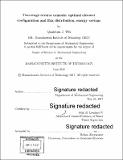Two-stage reverse osmosis : optimal element configuration and flux distribution, energy savings
Author(s)
Wei, Quantum Jichi
DownloadFull printable version (4.996Mb)
Alternative title
2-stage RO : optimal element configuration and flux distribution, energy savings
Optimal element configuration and flux distribution, energy savings
Other Contributors
Massachusetts Institute of Technology. Department of Mechanical Engineering.
Advisor
John H. Lienhard, V.
Terms of use
Metadata
Show full item recordAbstract
In a two-stage reverse osmosis (RO) system of finite size, there are two degrees of freedom not present in a single-stage RO system: distribution of RO elements between the two stages (system design), and feed pressures (system operation). In this study, we investigate the optimal system design and operation of a two-stage RO system with a mass-balance model and establish a lower bound for the energy savings achieved by the optimized two-stage system compared to a single-stage system. A two-stage RO system may consume more or less energy than a single-stage RO system of the same size and freshwater productivity, depending on the first-stage feed pressure and second-stage feed pressure. To minimize energy consumption, feed pressures should be chosen to minimize spatial variance in flux. The optimal element configuration places at least half the elements in the first stage; the exact configuration depends on feed salinity, recovery ratio, and membrane permeability. The greatest energy savings are achieved with a two-stage RO system that has both optimal element configuration and feed pressures. More energy can be saved by adding a stage when the thermodynamic least work of separation is larger. For a given feed salinity, energy savings from adding a second stage grow as recovery ratio increases. Brackish water feeds must be taken to high recovery ratios to achieve substantial energy savings; comparable savings can be achieved at lower recovery ratios for higher salinity feeds. We find that significant energy can be saved with the simplest two-stage RO design, at a system flux similar to today's RO plants and accounting for the effects of concentration polarization.
Description
Thesis: S.M., Massachusetts Institute of Technology, Department of Mechanical Engineering, 2017. Cataloged from PDF version of thesis. Includes bibliographical references (pages 57-59).
Date issued
2017Department
Massachusetts Institute of Technology. Department of Mechanical EngineeringPublisher
Massachusetts Institute of Technology
Keywords
Mechanical Engineering.